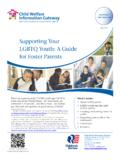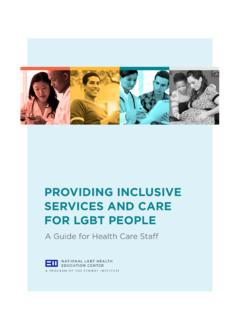Transcription of GUIDELINES FOR CARE OF LESBIAN, GAY, …
1 GUIDELINES FOR CARE OFLESBIAN, GAY, bisexual , ANDTRANSGENDERPATIENTST able of ContentsChapter 1 Creating a Welcoming ClinicalEnvironment for LGBT Patients..1 Background .. 1 Create a Welcoming Environment .. 2 General GUIDELINES for Formsand Patient-Provider Discussions .. 4 Confidentiality .. 8 Some Specific Issues to Discusswith LGBT Patients .. 9 Language .. 12 Staff Sensitivity and Training .. 13 Other Suggestions ..15 Sample Recommended Questionsfor LGBT-Sensitive Intake Forms .. 15 References and OtherResource Documents.
2 19 Chapter 2 Caring for Lesbian and BisexualWomen:Additional Considerations forClinicians..23 Chapter 3 Caring for Gay and bisexual Men:Additional Considerations for Clinicians..37 Appendices..53 Resources ..53 Acknowledgments ..60 CREATING A WELCOMINGCLINICAL ENVIRONMENT1cREATING A WELCOMINGCLINICAL ENVIRONMENT FORLESBIAN, GAY, bisexual , ANDTRANSGENDER (LGBT)PATIENTSjBackgroundStudies show that lesbian, gay, bisexual ,transgender and (LGBT) populations, inaddition to having the same basic healthneeds as the general population, experiencehealth disparities and barriers related tosexual orientation* and/or gender identity orexpression.
3 Many avoid or delay care orreceive inappropriate or inferior care becauseof perceived or real homophobia, biphobia,transphobia, and discrimination by health careproviders and in medical practice is a survey of nursing students showed that8 12% despised lesbian, gay, and bisexual (LGB) people, 5 12% found them disgusting, and 40 43% thought LGB people should keeptheir sexuality care providers can take positive steps topromote the health of their LGBT patients byexamining their practices, offices, policies andstaff training for ways to improve access to qualityhealth care for FOR CARE OF LGBT PATIENTSk1*the term sexual orientation is used in this documentto mean sexual orientation identities,behaviors, and/orattractions.
4 All of which are important in the healthcare FOR CARE OF LGBT PATIENTSk3uPost rainbow flag, pink triangle, unisexbathroom signs, or other LGBT-friendlysymbols or posters showing racially and ethnicallydiverse same-sex couples or transgenderpeople. Or posters from non-profit LGBT orHIV/AIDS brochures (multilingual whenpossible and appropriate) about LGBT healthconcerns, such as breast cancer, safe sex,hormone therapy, mental health, substanceuse, and sexually transmitted diseases(STDs also called sexually transmittedinfections or STIs such as HIV/AIDS, syphilis,and Hepatitis Aand B).
5 See Resources section for where to findbrochures and other or visibly post a non-discriminationstatement stating that equal care will beprovided to all patients, regardless of age, race,ethnicity, physical ability or attributes, religion,sexual orientation, or gender relevant days of observancein your practice such as World AIDS Day,LGBT Pride Day, and National TransgenderDay of LGBT-specific media, including localor national magazines or newsletters aboutand for LGBT and HIV-positive Resources sectionCREATING A WELCOMING CLINICAL ENVIRONMENTj2 There are some simple ways to make your practiceenvironment more welcoming and safe for yourLGBT patients.
6 Here are a few ideas to updateyour physical environment, add or change intakeand health history form questions, improveprovider-patient discussions, and increase staff sknowledge about and sensitivity to your LGBT patients. We hope you find this tool a Welcoming EnvironmentLesbian,gay, bisexual , and transgender (LGBT)patients often scan an office for clues tohelp them determine what information theyfeel comfortable sharing with their health in provider referral programs throughLGBT organizations ( , , , or local LGBT organizations)or advertising your practice in LGBT media cancreate a welcoming environment even before apatient enters the door.
7 If your office develops brochures or othereducational materials, or conducts trainings,make sure that these include relevant informationfor LGBT dialogue with a patient about their genderidentity/expression, sexual orientation, and/orsexual practices means more relevant andeffective may want to implement some of the followingsuggestions as appropriate for the type andlocation of your office: GUIDELINES FOR CARE OF LGBT PATIENTSuPrepare now to treat a transgender patientsomeday. Health care providers ignorance,surprise, or discomfort as they treat transgenderpeople may alienate patients and result in lowerquality or inappropriate care, as well as deterthem from seeking future medical individuals may have had traumaticpast experiences with doctors causing fear ormistrust.
8 Therefore, developing rapport andtrust with transgender patients may take longerand require added sensitivity from the talking with transgender people, askquestions necessary to assess the issue, butavoid unrelated probing. Explaining why youneed information can help avoid the perceptionof intrusion, for example: To help assess yourhealth risks, can you tell me about any historyyou have had with hormone use? uBe aware of additional barriers caused bydifferences in socioeconomic status, culturalnorms, racial/ethnic discrimination, age,physical ability, and geography.
9 Do not makeassumptions about literacy, language capacity,and comfort with direct talking about sexual or relationshippartners, use gender-neutral language suchas partner(s) or significant other(s). Askopen-ended questions, and avoid makingassumptions about the gender of a patient spartner(s) or about sexual behavior(s). Use thesame language that a patient does to describeself, sexual partners, relationships, and A WELCOMING CLINICAL ENVIRONMENTj4jGeneral GUIDELINES for Forms andPatient-Provider DiscussionsFilling out the intake form gives patients oneof their first and most important impressionsof your office.
10 The experience sets the tonefor how comfortable a patient feels being openabout their sexual orientation or page xx are recommendations for questionsyou may want to consider adding to your standardintake and health history forms, or ideally discuss with the patient while taking an oralhistory. Examples include more inclusive choicesfor answers to questions, open-ended questions,and adding partner wherever the word spouse is used. The following are additional topics forpossible inclusion in health history forms or tohelp a provider with in-person discussions withLGBT patients:uIntake forms should use the term relationshipstatus instead of marital status, includingoptions like partnered.








